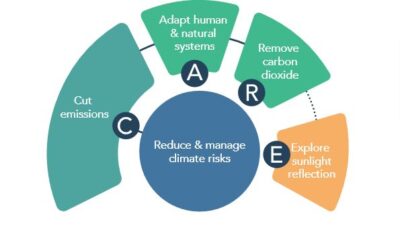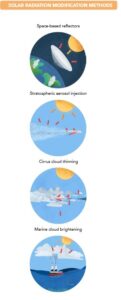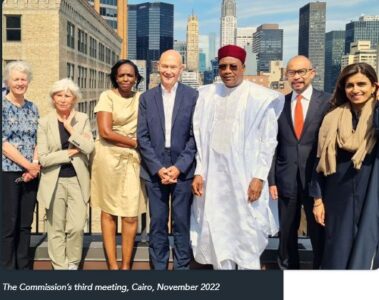The Overshoot Commission Addresses Geoengineering
The Commission tries to make it OK to talk about – not do – solar geoengineering. Its report proposes a moratorium, coupled with efforts to carefully build knowledge.
In this, my third post on the recently released report of the Climate Overshoot Commission, I’ll discuss their treatment of the most challenging and controversial part of their mandate, Solar Geoengineering or Solar Radiation Modification (SRM). As I noted in my introductory post on the Commission, I served as an advisor to the Secretariat and my students in the UCLA International Climate Law and Policy Clinic provided research and analytic support to the Secretariat. The commentary and discussion I’m posting are my own views, not those of the Commission.
As noted previously, the bedrock of the Commission’s charge was to take the prospect of significant climate overshoot and the associated risks seriously – which other high-level international climate bodies have not – and to think through how serious consideration of that risk changes how you think about all climate responses. Taking these risks seriously requires a willingness to at least consider extreme or radical responses, rather than double down on the same responses you were already pushing. This requires confronting potentially promising approaches that pose real challenges and difficulties – that people have been afraid to look at, that require a leap of imagination, that popular wisdom says are impossible – including responses you wish you didn’t have to consider, but which honest clear-eyed reflection says you have to. In my last post I discussed the Commission’s remarkably radical – and challenging – headline recommendation on mitigation, a global phaseout of fossil fuels. But no part of their mandate or report matches this description of “stuff you wish you didn’t have to think about, but realize you must” better than SRM. This is where the Commission faced its greatest challenges, where its clear-eyed view of the risks of overshoot was most strongly put to the test. In my view, they met the challenge very well.
The Commission approached SRM with great hesitation, reflecting their recognition of the top priority that must be given to mitigation and the significant new risks and uncertainties presented by SRM. They expressed particular caution, appropriately, against letting consideration of SRM be a distraction from mitigation and other responses, or an excuse for not making extreme efforts on them. The Commission summarized their complete set of  proposals as a “CARE Agenda” for reducing risks from overshoot: Cut emissions; Adapt; Remove; and Explore. Solar geoengineering falls under “Explore,” and there’s a reason it comes last. But the Commission also recognized that under conditions of substantial overshoot, there could soon be demands to use SRM, and that under some conditions using it may be better – for human welfare, especially the most vulnerable, and for non-human ecosystems – than not using it. Both possibilities – that there might be proposals to use it, and that doing so might be on balance beneficial – imply a need to learn more, by doing research and discussing governance needs and possibilities.
proposals as a “CARE Agenda” for reducing risks from overshoot: Cut emissions; Adapt; Remove; and Explore. Solar geoengineering falls under “Explore,” and there’s a reason it comes last. But the Commission also recognized that under conditions of substantial overshoot, there could soon be demands to use SRM, and that under some conditions using it may be better – for human welfare, especially the most vulnerable, and for non-human ecosystems – than not using it. Both possibilities – that there might be proposals to use it, and that doing so might be on balance beneficial – imply a need to learn more, by doing research and discussing governance needs and possibilities.
That the research done thus far – notwithstanding its uncertainties and limits, and the inability of research alone to resolve governance challenges – has consistently shown the possibility that SRM interventions might be broadly beneficial, especially for the most vulnerable regions, provides additional support for the Commission’s courageous decision to go where other bodies have been afraid to, and take a serious, careful, critical look. Recognizing the contentious arguments around SRM – and the acute tension it presents between potential benefits and harms, and associate deep uncertainties – they presented a carefully integrated and balanced set of recommendations. Considered together, as they must be, these represent real progress.
 First, they call for a moratorium on any large-scale SRM interventions. The proposal is that governments adopt the moratorium voluntarily, encouraging others also to adopt it by working with other governments directly and through multilateral institutions. This bottom-up approach aims to make adoption spread fast, avoiding the delay and potential rigidity of formal legal negotiations.
First, they call for a moratorium on any large-scale SRM interventions. The proposal is that governments adopt the moratorium voluntarily, encouraging others also to adopt it by working with other governments directly and through multilateral institutions. This bottom-up approach aims to make adoption spread fast, avoiding the delay and potential rigidity of formal legal negotiations.
Moratoria vary widely in their specifics, and these matter – most importantly, what activities are covered by the moratorium. In the Commission’s carefully crafted language, the moratorium would cover any SRM activity of such scale and intensity that it would present a risk of significant transboundary harm. This language invokes the foundational “no-harm” principle of customary international environmental law, first articulated in the 1941 Trail Smelter arbitration and subsequently re-affirmed in multiple international treaties, declarations, and tribunals. It is thus consistent with large body of prior international law.
The moratorium language is carefully crafted to avoid loopholes. Like the “no-harm” principle generally, it would apply to harms not just to the environments of other states, but also to areas beyond national jurisdiction such as the High seas and Antarctica. And it would apply to any activity above that threshold. Adopting states would apply it to their own actions, those done on their territory or under their control, and those done by their citizens or enterprises, even if conducted outside their territory. Recognizing that for SRM there is a blurry boundary between research at large enough scale and operational deployment, the moratorium applies to all activities above the threshold, regardless of purpose: in other words, you don’t get to evade the moratorium by calling the large-scale intervention you are proposing research, not deployment.
 The one way in which the moratorium proposal is less restrictive than some proponents of an SRM moratorium would prefer is that the “risk of significant transboundary harm” threshold is quite high. By requiring both “transboundary harm” and “significance,” it would not bar all activities with minimally detectable transboundary effects – which is a moving target in any case, changing as detection capability advances. It would apply only to activities causing material harm, not activities deemed objectionable for symbolic or other non-material reasons. It would not bar all outdoor SRM experiments – of which all now contemplated are many orders of magnitude below the moratorium threshold. At the same time, nothing in the Commission’s recommendations would obstruct states from enacting tighter restrictions if they wish.
The one way in which the moratorium proposal is less restrictive than some proponents of an SRM moratorium would prefer is that the “risk of significant transboundary harm” threshold is quite high. By requiring both “transboundary harm” and “significance,” it would not bar all activities with minimally detectable transboundary effects – which is a moving target in any case, changing as detection capability advances. It would apply only to activities causing material harm, not activities deemed objectionable for symbolic or other non-material reasons. It would not bar all outdoor SRM experiments – of which all now contemplated are many orders of magnitude below the moratorium threshold. At the same time, nothing in the Commission’s recommendations would obstruct states from enacting tighter restrictions if they wish.
The Commission does not state specific recommendations for conditions to end the moratorium, but instead invokes two widely stated pre-conditions for large-scale interventions: enough knowledge from research to support informed decision-making; and an adequate framework to govern proposed interventions. Since the specific knowledge and governance conditions that would meet this standard cannot be codified in advance, this is about as good as you can get. Although some moratoria include explicit time limits, this proposal does not – and arguably could not realistically do so, in view of the uncertain time-scales for both further progression of climate harms, and achievement of the stated scientific and governance requirements.
The Commission’s next two SRM recommendations are strongly linked: substantial expansion of SRM research, and strengthened research governance specific to SRM. While recommending a substantial expansion of research, the Commission stresses that this implies no stance either for or against future use. In addition, they correctly note that even a large expansion from present levels would still leave SRM research a tiny fraction of all climate research. Beyond broadly noting that SRM research should aim to advance understanding of its effects on the climate system, the environment, and society, the report does not propose a substantive agenda for research. Although several other bodies have recently done so, the Commission understood that it was a policy body, not a scientific one.
The details that elaborate their recommendation to expand research overlap strongly with their recommendations for stronger governance. For example, they recommend strong international cooperation in research, with particular emphasis on collaborative activities involving and led by scientists from developing nations. Research could be coordinated through international bodies and linked to periodic international scientific reviews and assessments, with several existing organizations identified as possible sites for these functions, including WMO, UNEP, IPCC, GRC, and the Future Earth program.
Beyond these international coordination and assessment processes, the Commission suggests that other research governance needs can be met within existing national regulatory frameworks, with some additional measures to address specific concerns raised about SRM research. These additional measures include enhanced transparency provisions to make many aspects of the aims, methods, funding, and results of research broadly publicly available and understandable; avoiding SRM research being led or funded by private firms, particularly from industries that may have interests in delaying large emissions cuts; and provisions for periodic review and assessment that provide clear mileposts and exit ramps, to resist potential pressures to continue or expand research even if conditions and results do not warrant it.
Within SRM research, the most controversial piece by far has been proposals to do active experiments – which would introduce a little bit of material into the environment and observe what happens. The controversy over these is in some respects puzzling, because all experiments proposed or contemplated, and any associated impacts or risks, are tiny – thousands to billions of times too small to have minimally detectable climate effects beyond the immediate experimental site. One widely criticized experiment – which has been proposed but never done – would spray about 1 kilogram of Sulfur from a balloon floating in the stratosphere. Yet at the same time, these physical impacts are all that distinguishes field experiments from other SRM research – lab, model, or passive observation – that have not attracted similar controversy.
 Like the experienced political leaders they are, the Commission simply took the fact of the controversy over field experiments as given, without going into the arguments over whether it makes any sense. On that basis, they recommended a few additional governance provisions specific to field experiments. These are all additional precautionary controls they recommend for this research: there is nothing in their recommendations that would limit a jurisdiction from controlling these more tightly – or even bar them on its territory, as Mexico has expressed an intention to do in response to the sovereignty-offending (but materially trivial) “Make Sunsets” debacle.
Like the experienced political leaders they are, the Commission simply took the fact of the controversy over field experiments as given, without going into the arguments over whether it makes any sense. On that basis, they recommended a few additional governance provisions specific to field experiments. These are all additional precautionary controls they recommend for this research: there is nothing in their recommendations that would limit a jurisdiction from controlling these more tightly – or even bar them on its territory, as Mexico has expressed an intention to do in response to the sovereignty-offending (but materially trivial) “Make Sunsets” debacle.
First, the Commission recommends that these experiments should not be conducted in jurisdictions that lack effective environmental regulatory regimes – in effect, a caution against researchers shopping for lax jurisdictions where they can cut corners. When experiments are conducted under effective environmental protection regimes, the Commission recommends that the degree of regulatory scrutiny and specific requirements should increase with the contemplated scale of the experiment. Several previous bodies have made similar recommendations, going back to the UK Royal Society report of 2009 and the Asilomar Conference declaration of 2010, but the Commission adds more specifics. In particular, they suggest that the first level of heightened scrutiny specific to SRM experiments – beyond the normal requirement to comply with all applicable environment, safety, and other regulations that apply to any field research – might be aligned with the legal thresholds that trigger requirements for formal Environmental Impact Assessment. In most states, this is some variant of an activity anticipated to have a “significant environmental impact.” In addition to normal EIA procedures, the heightened requirements for experiments above this threshold might include additional levels of scientific review that require demonstrating the value or necessity of the proposed scale of activity, or heightened requirements for transparency and consultation. Within the overall governance regime, if proposed activities pass further specified thresholds beyond the initial EIA trigger there could be additional requirements. These might include, for example, engagement in international coordination or harmonization processes, partnership with developing-country researchers or research institutions, or support for broader knowledge-building or governance development activities.
Finally, in parallel with its calls for expanded research and research governance, the Commission also recommends broad consultations and dialogs on the novel and severe governance challenges SRM will pose, particular if there are calls to use it. In effect, the Commission recommends that the intensive process it itself has gone through — of education, consideration of still uncertain but potential large benefits and risks, and deliberation over responsible choices in pursuit of a safer and more equitable world – be replicated and extended, with diverse participation, in community, domestic, and international settings. In view of the deep uncertainty that permeates what will, can, or should happen – on climate change overall and on SRM’s role within it, if any – they stress that these consultations should not pursue early policy or legal action, but should be exploratory and informative, aiming to build knowledge, develop creative ideas and insights, and develop norms and trust.
Overall, the Commission’s discussion of SRM is an impressive piece of work. Its recommendations form a coherent whole that presents a comprehensive, reasoned, and careful approach – an approach that offers measured exploration of these high-stakes responses to build knowledge and capacity to address present and future challenges, coupled with measures to limit associated risks. The pieces work together to promote growth in knowledge and capacity while also addressing the concerns that have been raised about SRM. The recommendation for expanded research is coupled with calls for research governance measures that address the most widely identified concerns – seriously and substantively, while not claiming to deliver unattainable certainty – while still letting research proceed. The specific recommendations for more careful scrutiny of field experiments respond seriously to the fact of strong concerns about these – without relying on arguments that the direct environmental effects of these are trivial, which have clearly not assuaged the concerns. The call for periodic scientific assessments and reviews, and built-in mileposts to re-assess research programs, limit risks of unreasoning continuance or expansion toward deployment – variously analogized as lock-in or slippery-slopes. This applies even more strongly to the call for a moratorium, which by reducing alarm that someone might be about to pursue a large-scale intervention, can also allow space for research to better understand SRM’s promise and risks, and for deliberations on how to control these. One of the most consistent objections to SRM research has been the expectation that research programs would expand thoughtlessly into full-scale deployment, even if conditions of knowledge and governance capacity needed to make that advisable are not present. The proposed moratorium would provide some assurance against this scenario, certainly against a hasty or impetuous move that way.
In one sense, the Commission’s recommendations on SRM are not radical or surprising. Their calls for linked research expansion and additional research governance are similar to proposal advanced by several bodies, notably the UNEP Expert Group report in February 2023, as well as two recent widely circulated scientists’ open letters. But they represent an important step forward – both because of important new elements that have not previously been stated together, such as linking the research and research governance recommendations with the carefully crafted moratorium; and because of the politically expert character, the global reach, and the stature of the Commission – which moreover approached this issue as relative newcomers, without preconceptions.
So, what happens now? I can envision two possibilities. First, the recommendation for a moratorium is likely to attract significant attention – as early press reports and other reactions to the Commission suggest. I predict there may be multiple proposals from governments in international settings – including major upcoming events such as COP28 in December and the sixth UNEA next March – to push such a moratorium. I also predict substantial conflict and confusion, some of it intentional, over what such a Moratorium would mean – in particular over what it would actually cover. Sophisticated commentators on international affairs will understand what the Commission intends with its moratorium, and the rationale for a moratorium with such a scope. Opponents of researching or discussing SRM, some of whom have already weighed in in response to the Commission, are likely to support the idea of a moratorium in principle, but push for one with much broader scope, possibly including all field experiments no matter how small.
Second, proposals for expanded and more systematically directed SRM research are coming forward from many quarters. But long-standing concerns about whether and how additional research governance is needed, and discussions over how to concretely meet these needs, have made little progress. New funding proposals will increase the need for these and intensify the associated controversies. Given the Commission’s stature, global diversity, and prominence, I expect its balanced approach, and promising but incomplete specification of particulars, to be highly influential in shaping these debates. The debates will have to continue in other fora, however, which incorporate scientific, policy, civil-society, citizen, and research sponsor views.






Reader Comments